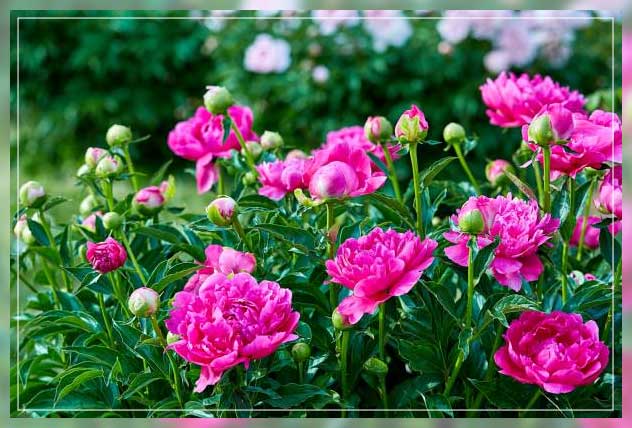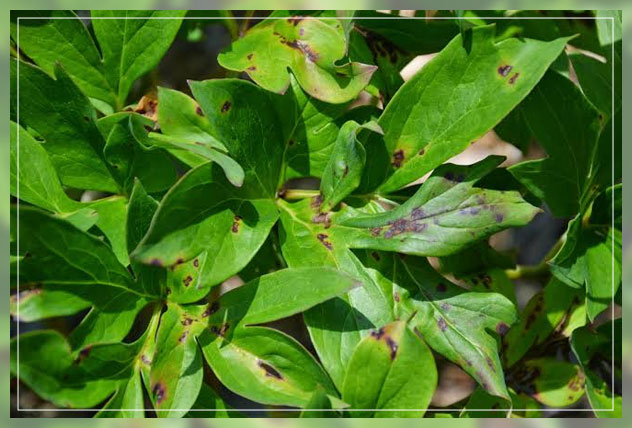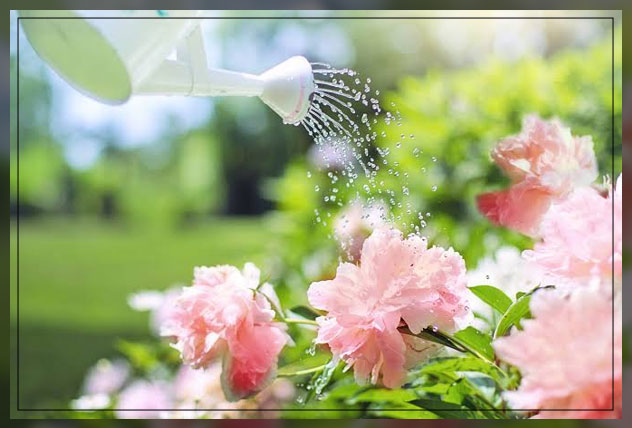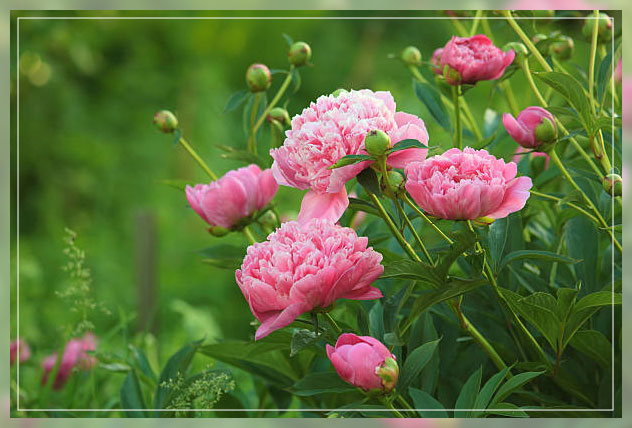The peony flower is a spring-blooming star of the garden and has large, showy blooms, heady aromas, and tons of personality.
By some estimates, there are as many as 33 different species within the genus Paeonia. And these are collectively known as peonies.
It is important to note that most of these are herbaceous perennials, though a few tend to woody shrubs.
Moreover, peonies are medium-sized and have tuberous roots that are a combination of thick storage roots.
Its thin roots are designed to absorb water and nutrients.
Careful handling of these roots is critical to planting or transplanting peonies, as well as when you are dividing the plants to propagate them.
Keep on reading to learn more about a Peony Flower.
Peony Flower
It is important to note that slow-growing peonies are categorized in a number of different ways like by flower type or by growth habit.
In addition to the familiar garden variety, herbaceous peonies tend to have a number of flower variations.
Moreover, there are special types like fern-leaf peonies, Paeonia tenuifolia, a particularly sensitive and prized species.
And tree peonies are woody, upright forms. These types have special planting needs.

It is important to note that the bloom time of peonies tends to vary from late spring to early summer, depending on the variety.
However, all types are best planted in fall about 6 weeks before the ground freezes.
This gives the plant time to settle in and establish roots before winter.
Furthermore, this is especially true when you plant bare-root peonies or when transplanting but when planting pooted peonies, fall planting gives better results than spring planting.
Quick Facts about Peony Flower
Some quick facts about peonies are:
| Botanical Name | Paeonia officinalis |
| Common Name | Peony |
| Plant Type | Herbaceous perennial, or woody shrub |
| Sun Exposure | Full sun |
| Soil Type | Well-draining |
| Soil pH | 6.5-7.0 |
| Bloom Time | Late spring to late summer |
| Flower Color | White, pink, rose, red, deep purple, and coral |
| Hardiness Zones | 3-9 (depending on variety) |
| Native Area | Asia, Europe, and Western North America |
| Toxicity | Mildly toxic to humans, toxic to pets |
One of the interesting facts to note about pink peony is that people believe it brings good fortune. Giving a peony bouquet with white peony to someone is a kind gesture.
Peony Flower Care
Peonies are classic garden plants that tend to thrive for decades with minimal care when you plant them in soil that meets their needs.
One of the longest-lived of all garden plants, peonies are, in some cases, handed down from generation to generation in families.
It is important to do initial planting in the right way.
This is because peonies can be temperamental about moving once they establish in the soil.
Moreover, it is important that you give each peony plant space to grow to maturity without crowding them.
This means that a 3 to 4-foot diameter for each plant is a good option for growing them.
Choose a location that shelters the plant from strong winds.

The large heavy blooms of this plant can cause the stems to flop over during heavy rain and inclement weather.
Your peonies will benefit from some type of support staking, so plant them well away from trees and shrubs, as they do not like to compete for nutrients and water.
Furthermore, peonies like good chill weather. In order to set their flower buds, peony roots should be placed relatively close to the surface of the soil, only about 2 to 3 inches deep.
It may feel odd to leave the roots exposed, however, they will need this chilling to attain dormancy and set buds.
Learn more about Plant Nutrients for Crop Production here.
Light and Soil Requirments
Peonies flowers will need a location that tends to receive at least 6 hours of sunlight each day and a full day of sun is even better for them.
Without sufficient light, you will notice fewer blooms and smaller flowers and the plant will have a greater risk of fungal diseases.
It is important to note that peonies are very adaptable, but ideally, they tend to like a well-drained slightly acidic soil, 6.5 to 7.0pH.
However, if you are planting them in heavy, clay soil, then make sure to amend the soil with compost or a soil mix that is for azaleas and rhododendrons.
This will make it easier for the plant to settle in.
As peonies like to remain in the same spot for upwards of 70 years, take time to prepare the soil before planting them.
On the other hand, tree peonies tend to like slightly more alkaline soil than standard herbaceous peonies, and they do not want to compete with other shrubs.
Learn more about Soil Amendments: Improving the Garden Soil here.
Water, Temperature, and Other Requirments
Peonies will need moist, well-drained soil to thrive in. Ideally, they should receive at least 1 to 2 inches of water weekly.
Moreover, they can thrive in relatively wet areas, however, are not drought resistant.
Make sure to mulch your plants to help them retain water and lessen the chances of weeds.
Peonies tend to prefer cooler areas, hardiness zones of 3 to 8, and do best when you experience cold winters.
However, feed your plants lightly. An annual application of compost mixed with a small amount of fertilizer around the base of the plant is all they need.
When you do feed them with compost and fertilize, do it after the plants have finished blooming.

However, do not smother peonies with mulch in winter.
In the first winter season, you can mulch loosely with pine needles or shredded bark but mulch should be promptly removed in spring.
Tree peonies will need iron and phosphate and will do well with an annual feeding of sulfate and bone meal in spring.
Unlike herbaceous peonies, they will need regular feeding with a 5-10-5 fertilizer.
Learn more about Types of Organic Fertilizers here.
Peony Varieties
Some popular peony flower varieties are:
Big Bean: Boasts magenta flowers and a heady aroma.
Festiva Maxima: Shows white blooms with specks of magenta.
Pillow Talk: Offers giant pink flowerheads with touches of yellow
Spider Green: Has a yellow center and large white petals.
Sweet Marjorie: Presents hearty dark pink blooms.
Pruning and Propagating Tips
It is important to note that peonies will need little pruning. Once your plant finishes the blooming season, cut back dead stems and branches.
However, if the stem appears diseased, cut back before the affected parts.
If two branches rub agaisnt each other, remove the least desirable branch.
When pruning peonies, make sure to always cut back to right above the first bud.
Peonies are best propagated by lifting and dividing the root clump, and immediately replanting the divided species.
A peony will need this after about 10 years when it begins to lose its vigor and becomes root-bound.
Here, too, fall is the best time for this activity, and just before you plan to divide, cut the foliage of the peony back down to the ground level.
Dig up the entire plant and remove as much soil as possible by soaking it with a hose.

Using your hand, manipulate the roots into dividable portions each with 3-5 eyes, small reddish buds that resemble potato eyes.
Then use a sharp knife to cut the tuberous root clump into divisions.
Cut away all the tiny roots on each division, leaving only the large, fleshy roots.
Then, replant the divisions as soon as possible, following the above instructions.
Potting and Repotting Peony Flower
In most cases, you will get peonies as potted plants in 1/2 or 1-gallon containers at the nursery or as bare roots, often with peat moss or wood shavings in plastic bags.
The peonies at the plant society sales or plant swaps are often tuberous bare-root varieties.
When choosing potted peonies, make sure to look for healthy specimens without leaf spots or week-looking stems.
Moreover, when planting from bare tuberous rooks, make sure that the root clump has at least three to five eyes.
These eyes will elongate and become the stems of the plant.
A mature peony will be at least 3 to4 years old before it is divided into bare roots. Tuberous clumps, however, with only one or two eyes may still grow.
But they will take longer to become established blooming plants.
When you move an already established plant, transplanting them should be carefully done as it can disturb the roots any more than necessary.
These plants tend to thrive in the same spot for decades, but moving one hastily can bring about their demise.
As with any planting, fall is the best time to move a peony flower.
At the new panting site, till up the soil at least 12 to 18 inches, and mix a 4-inch layer of compost or peat moss.
Water with 1-inch of water a day or two before transplanting, and your peony should be well hydrated before moving it.
Dig around the root ball of the peony using a sharp spade, getting as much soil as possible. Slide a tarp under the root ball to keep it intact.
Then lift the plant from the ground and carefully carry or slide it to a new location or spot.
At the new spot, dig a hole that is twice as wide as the root ball of your plant and exactly as deep as the root ball.
Plant the peony flower at exactly the same depth as it was in the old locations. Backfill the plant.
Tamp the soil down with your hands but do not pack it too tightly.
Water thoroughly and add a 3-inch layer of compost or mulch around the base of the plant.
This will help keep your plant roots moist and cool while the plant tends to establish itself in its new location.
Common Pests and Diseases
It is important to note that peonies are especially prone to gray mold or botrytis.
To fight off this disease, make sure that you do not plant your peony flowers too close to each other, making sure air circulates between them.
Moreover, using copper soap fungicides can help as well.
Gardeners often find peony blooms covered with ants which are attracted to nectar that highly fragrant flowers secrete.
The ants, however, do not harm the plant, and in fact, act as a deterrent to other floral insects that may carry disease or otherwise damage the plant.
Moreover, the ants are likely unwelcome addition to your cut flower.
Simply give your cut peonies a gentle shake before bringing them indoors for decorations.






Leave a Reply